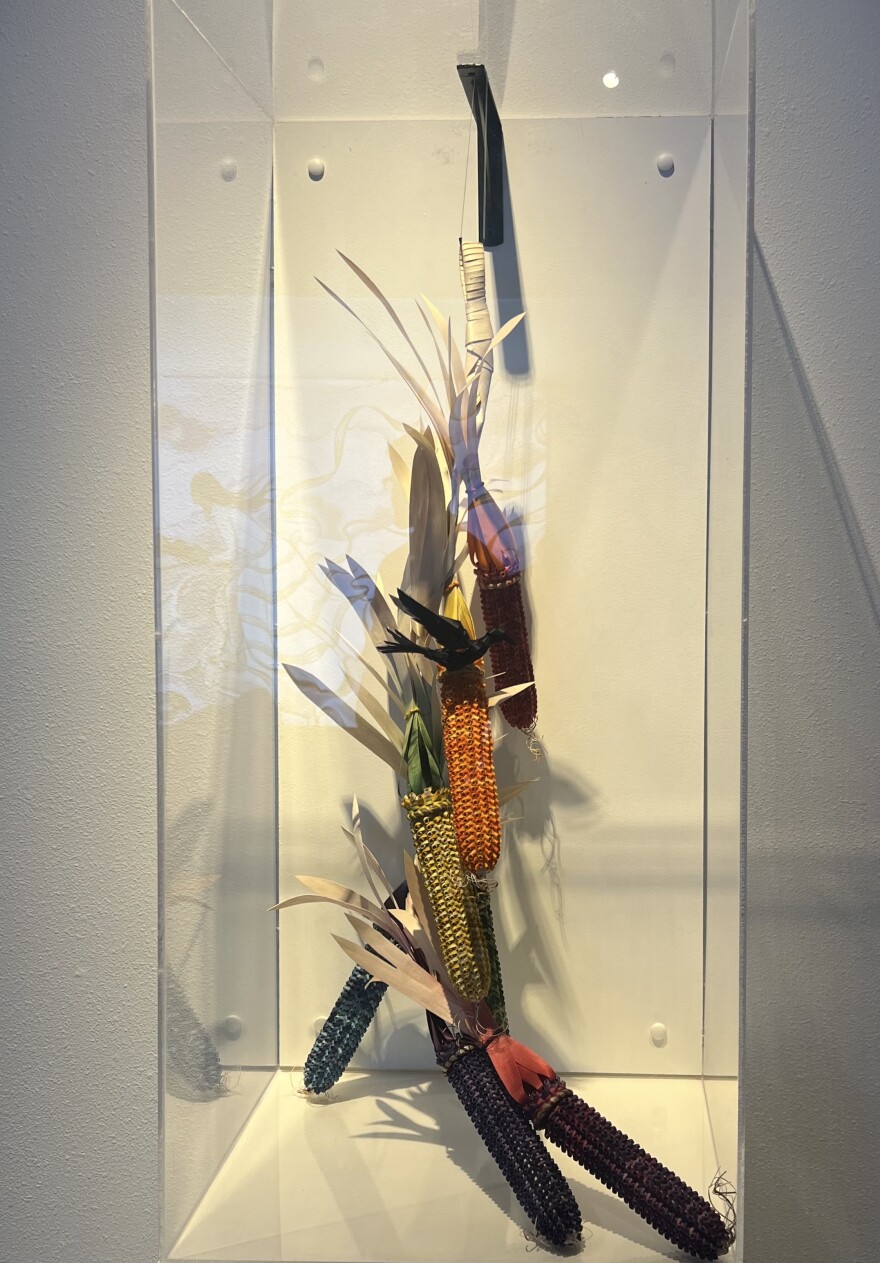A new exhibit at the Museum of Natural and Cultural History in Eugene features work by Indigenous queer artists answering the question: “What does it mean to exist at the intersection of Indigeneity and queerness?”

At the May 15 opening reception for “Transgressors,” visitors milled about, taking it all in. There is a large variety of art in all shapes and sizes. Pieces include intricate beadwork from Séliš artist, Roin Morigeau, surrounding their feelings on top surgery; and Geo Neptune’s sculpture of corn painted in different colors of the rainbow strung together in the Wabanaki basket weaving tradition.
Anthony Hudson, a member of the Siletz tribe and the Confederated Tribes of Grand Ronde, is one of the curators. He said it includes the work of Indigenous queer artists all over, from Oregon to Hawaii.
“We really wanted to show what … queer indigeneity [looks] like for all of us across all of these different nations,” explained Hudson. “Where are we similar? Where are we different? And just really show the breadth of queer Indigeneity.”
The Transgressors project builds upon an earlier exhibit by Hudson and co-curator Felix Furby, called “My Father’s Father’s Sister.” It focused on Shimkin, an Atfalati Kalapuyan ancestor who was transfeminine.
After having an exhibit that centered on the past, Furby said the next logical step was to move forward, into the present and future. For them, this meant an exhibit where queer Indigenous artists get to choose what their future looked like.
“We're talking about trying to, you know, reincorporate what has been taken from us back into our lives,” said Furby. “But we're also talking about having the agency to choose what our lives are going to look like.”
A moment of laughter and silliness

For artist Steph Littlebird, a member of the Chinook and Kalapuya tribes, queer Indigeneity includes joy and fun.
For the exhibit, one of the pieces she created was a vending machine that dispensed different forms of artworks, such as her interpretation of a Two-Spirit Pride Flag and a drawing of White Cindy, a Klamath ancestor who was transfeminine.
“Whether you are a queer, marginalized person or a person of color who is marginalized, joy is something that can be kind of like off-limits to us in some ways, or is something that we … experience few and far between,” said Littlebird. “And so the vending machines are this way of creating a moment of laughter, and just like silliness within the show.”
Additionally, for Littlebird, it is important to highlight Indigenous futurism. She wants people to break away from what they think of when they think of Indigenous people.
“They see us as stereotypes from an old movie, or they see us in black and white photos, but they actually don't ever get to see us as we are now,” explained Littlebird. “And so all of the work that I do as an artist in every format, in every medium, is about making people understand indigenous people from a contemporary perspective.”
‘Partake with us’
This is also highlighted in the way Hudson and Furby have chosen to display the artwork. Instead of plaques, there are large pictures of the artists around the eye level of the viewer.
“There are countless museums across the world where our ancestors' bones are kept and held and stolen,” said Hudson. “And so with this show, it was really crucial to point out [that]not only is this artwork celebrating queer Indigeneity, but we want to celebrate the artists and the idea of us as people, and us as people that deserve a role and a place in community, and that have bodies and feelings and hearts and thoughts.”
Beyond futurism, Hudson also said this was about the humanity of queer Indigenous artists and also about creating community with them.
“This is not ‘look at us as specimens.’ This is ‘partake with us,’” said Hudson.
The Transgressors Exhibit will be at the Museum of Natural and Cultural History on the University of Oregon campus in Eugene until Jan. 4, 2026.






